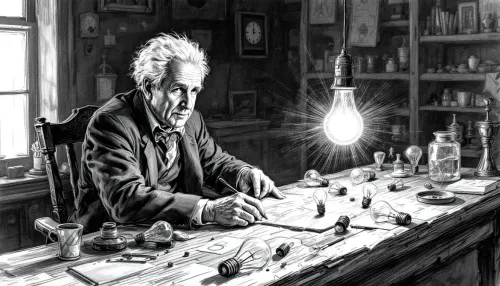Edison's Lightbulb Moment: 1,000 Tries to Illumination

Have you ever heard someone say “If at first you don’t succeed, try, try again”? That sounds nice in theory, but would you keep trying a thousand times? Today I want to tell you about Thomas Edison and how he approached creating the light bulb we know today - a journey that took over 1,000 attempts.
Before Edison, other inventors had created electric lights, but they would burn out very quickly - sometimes in just a few minutes! Edison knew there had to be a better way. He believed he could create a light bulb that would last long enough to be practical in people’s homes.
The key was finding the right material for the filament - that’s the thin wire inside the bulb that glows when electricity passes through it. Edison and his team didn’t just try things randomly. They made a list of materials with properties they thought might work: platinum, cotton thread, fishing line, coconut fiber, and even hair from someone’s beard! They tested each one systematically.
Try to imagine testing 1,000 different materials and ways of making a light bulb. That’s like trying to solve a math problem wrong every day for almost three years! But Edison didn’t see these as failures. He famously said, “I have not failed 1,000 times. I have successfully discovered 1,000 ways to NOT make a light bulb.”
Finally, in 1879, Edison found that a carbonized bamboo filament could last over 1,200 hours - that’s 50 days! This discovery changed the world, making it possible to light homes with electricity instead of gas lamps or candles.
When I think about Edison’s story, I wonder how he felt at his 100th failure or even his 900th failure. What kept him going wasn’t just determination - it was his methodical approach. He had a clear goal, and even though he didn’t know if it was possible, he carefully tracked what didn’t work and used that information to guide his next attempts. This systematic approach, I believe, is the key to tackling hard problems without losing faith.
I find myself getting frustrated when things don’t work out, but then I remember Edison’s approach. Instead of giving up or trying the same thing repeatedly, I try to step back and think: “What have I tried? What haven’t I tried yet? What did I learn from what didn’t work?” Having a plan makes the frustration easier to handle - though I’ll admit, being patient still isn’t easy for me!
The next time you’re stuck on a seemingly impossible problem, try thinking like Edison. Make a list of different approaches you could try. Keep track of what doesn’t work and why. What problem would you like to tackle using Edison’s approach?
Love, Abba

